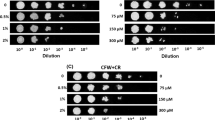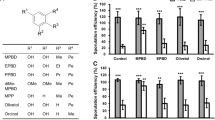Abstract
The effects of sodium azide and trifluoperazine on growth, cAMP-chemotaxis, morphogenesis and cell differentiation in the slime mouldDictyostelium discoideum were examined. Growth rate of cells pretreated with low chemical concentrations was reduced directly after the treatment but was partially recovered within two to three hours. The levels of growth inhibition were directly proportional to the chemical concentrations. Low concentrations of trifluoperazine (1 μM) had no clear effect on the morphogenesis of the wild type strain HM27, but induced partial phenotype correction in the final fruiting body of the sporogenous mutant HM28. On the other hand, all relatively non toxic treatments with sodium azide had no effect on morphogenesis of both strains and on cell differentiation of the wild type strain HM27. Both trifluoperazine and sodium azide shifted cell differentiation of the sporogenous mutant HM28 in monolayers from spore- to stalk-pathway. Higher concentrations of both chemicals inhibited cell differentiation in all strains completely. The results indicated that these chemicals influenced the effects of the sporogenous locus which plays a role in the spore/stalk determination mechanism in the sporogenous mutant HM28.
Similar content being viewed by others
References
Berks M and Kay R 1988 Cyclic AMP is an inhibitor of stalk cell differentiation inDictyastelium discoideum;Dev.Biol. 126 108–114
Chafouleas J G, Bolton W E, Hidaka H, Boyd A E and Means A R 1982 Calmodulin and the cell cycle involvement in regulation of cell cycle progression;Cell 28 41–48
Dinauer M C, MacKay S A and Devreotes P N 1980 Cyclic 3,5-AMP relay inDictyostelium discoideum III. The relationship of cAMP synthesis and secretion during the cAMP signalling response;J. Cell Biol. 86 537–545
Europe-Finner G N and Newell P C 1986 Inositol 1,4,5-triphosphate induces calcium release from a non mitochondrial pool in amoebaeof Dictyostelium;Biochim. Biophys. Acta 887 335–340
Europe-Finner G N and Newell P C 1987 Cyclic AMP stimulates accumulation of inositol triphosphate inDictyostelium;J. Cell. Sci. 87 221–229
Fontana D R and Devreotes P M 1984 Cyclic AMP-stimulated adenylate cyclase activation inDictyostelium discoideum is inhibited by agents acting at the cell surface;Dev. Biol. 106 76–82
Gomer R, Armstrong D, Leichtling B and Firlel R 1986 Cyclic AMP induction of prespore and prestalk gene expression inDictyostelium is mediated by the cell-surface cAMP receptor;P roc. Natl. Acad. Sci. USA 83 8624–8628
Hait W N and Lee G L 1984 Characterization of the cytotoxic effects of calmodulin inhibitors;Clin. Res. 32 416A
Ishida S 1980 The effects of cAMP on differentiation of a mutantDictyostelium discoideum capable of developing without morphogenesis;Dev.Growth Differ. 22 781–788
James W O 1953 The use of respiratory inhibitors;Annu. Rev. Plant Physiol 4 59–90
Kay R R, Garrod D and Tilly R 1978 Requirement for cell differentiation inDictyostelium discoideum;Nature (London) 271 58–60
Kleinhofs A, Owais W M and Nilan R A 1978 Azide;Mutat. Res. 55 165–195
Kimura H, Mittal C K and Murad F 1975 Activation of guanylate cyclase from rat liver and other tissues by sodium azide;J. Biol. Chem. 250 8016–8022
Klein P, Sun T, Saxe III C, Kimmel A, Johnson K and Devreotes P A 1988 Chemoattractant receptor controls development inDictyostelium discoideum;Science 241 1467–1472
Loomis W F 1982The Development of Dictyostelium discoideum (New York: Academic Press)
Milne J L and Coukell M B 1988 Isolation and characterization of a plasma membrane calcium pump fromDictyostelium discoideum;Biochem. J. 249 223–220
Milne J L and Coukell M B 1991 A Ca2+ transport system associated with the plasma membrane ofDictyostelium discoideum is activated by different chemoattractant receptors;J. Cell Biol. 112 103–110
Osborn M and Weber K 1980 Damaged cellular function by trifluoperazine, a calmodulin specific drug;Exp. Cell Res. 130 484–489
Oyama M and Blumberg D 1986 Interaction of cAMP with the cell surface receptor induces cell-type-specific mRNA accumulation;Proc. Natl. Acad. Sci. USA 83 8419–4823
Owais W and Sadiq M 1993 O-acetyl-serine sulfhydrylase from different organisms converts azide to a mutagenic metabolite: Ability of the metabolite to inhibit the enzymein vitro;Abhath al Yarmouk Pure Science and Engineering Series 2 43–55
Riley B, Jensen B R and Barclay S L 1989 Conditions that elevate intracellular cyclic AMP levels promote spore formation inDictyostelium;Differentiation 41 5–13
Riley B and Barclay S 1986 Inhibitors of intracellular cyclic-AMP accumulation affect differentiation of sporogenous mutantsof Dictyostelium discoideum;FEMS Microbiol. Lett. 37 221–226
Ross W and Gerisch G 1976 Receptor mediated adenylate cyclase activation inDictyostelium discoideum;FEBS Lett. 68 170–172
Rubin J and Robertson A 1975 The tip of theDictyostelium discoideum pseudoplasmodium as an organizer;J. Embryol. Exp. Morphol. 33 227–243
Sadiq M F 1986A Study of Cell Differentiation in the Cellular Slime Mold Dictyostelium discoideum: Genetic and Biochemical Approaches, Ph.D thesis, Case Western Reserve University, Cleveland, Ohio, USA
Sadiq M F and Town CD 1991 Characterization and complementation analysis of sporogenous mutants ofDictyostelium discoideum;Dev. Genet. 12 272–280
Sadiq M F and Town C D 1993 Effects of Caffiene, meclofenamate and concanavalin A on cell differentiationof Dictyostelium discoideum sporogenous mutants (Group II);Dirasat (Pure Appl. Sci.) 20B 123–134
Schaap P 1991 Intercellular interactions duringDictyostelium development; inMicrobial Cell-Cell Interactions (ed) M Dworkin (New York: American Society for Microbiology Press) pp 147–178
Shafer B 1975 Secretion of cyclic AMP induced by cyclic AMP in the cellular slime mouldDictyostelium discoideum;Nature (London) 255 549–552
Spudich J A 1987Methods in Cell Biology (New York: Academic Press)
Spemann H 1938Embryonic Development and Induction (New Haven: Yale University Press)
Stannard J M and Horecker B L 1948 Thein vitro inhibition of cytochrome oxidase by azide and cyanide;J. Biol. Chem. 172 599–608
Town C D 1984 Differentiation ofDictyostelium discoideum in monolayer cultures and its modification by ionic conditions;Differentiation 27 29–35
Town C D, Gross J D and Kay R R 1976 Cell differentiation without morphogenesis inDictyostelium discoideum;Nature (London) 262 717–719
Uzonov P and Weiss B 1972 Separation of multiple molecular forms of cyclic adenosine 3,5,monophosphate in rat cerebellum by Polyacrylamide gel electrophoresis;Biochim. Biophys. Acta 284 220–227
Van Duijn B and Inouye K 1991 Regulation of movement speed by intracellular pH duringDictyostelium discoideum Chemotaxis;Proc. Natl. Acad. Sci. USA 88 4951–4955
VanHaastert P J M,DeVries M J, Penning L C, Roovers E,KaayVan der J, Erneux Cand vanLookeren Campagne M M 1989 Chemoattractant and guanosien 5’[γ-thiol] triphosphate induce the accumulation of inositol l,4,5,triphosphate inDictyostelium discoideum cells that are labelled with3H-inositol by electroporation;Biochem. J. 258 577–586
Wallace J and Fraizer W A 1979 Photoaffinity of cyclic-AMP-binding proteins of differentiatingDictyostelium discoideum cells;Proc. Natl. Acad. Sci. USA 76 4250–4254
Wurster B, Schubiger K, Wick U and Gerisch G 1977 Cyclic GMP inDictyostelium discoideum: oscillations and pulses in response to folic acid and cyclic AMP signals;FEBS Lett. 76 141–144
Author information
Authors and Affiliations
Rights and permissions
About this article
Cite this article
Sadiq, M.F. Effects of sodium azide and trifluoperazine on growth, development and monolayer cell differentiation inDictyostelium discoideum . J. Biosci. 20, 481–491 (1995). https://doi.org/10.1007/BF02703531
Received:
Revised:
Published:
Issue Date:
DOI: https://doi.org/10.1007/BF02703531




